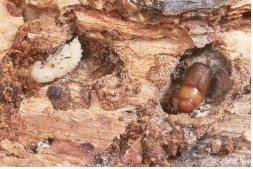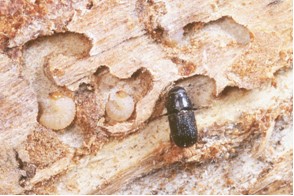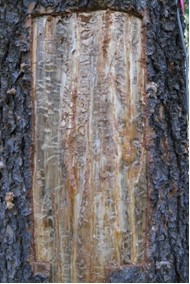Mountain pine beetle
Learn about the mountain pine beetle and how you can help prevent the introduction and spread of this invasive species.
What Ontario is doing
To prevent this unwanted invader from coming into the province, Ontario has regulated mountain pine beetle (Dendroctonus ponderosae) as a prohibited invasive species under the Invasive Species Act, 2015.
Learn about the Invasive Species Act and regulations.
Background
Mountain pine beetle is a small bark beetle that relies on a host tree to feed and lay its eggs. They reside in boreal forest habitats that contain pine species, preferably lodgepole pine, but can feed on most native pine species.
Ontario’s Canadian Shield habitat is particularly vulnerable due to its large populations of jack pine trees that provide habitat for this beetle.
Cold winters have typically controlled beetle populations, however, the movement of infested wood products and climate change, have allowed this species to spread outside of its native range with a greater number of larvae surviving.
Range
Mountain pine beetle is native to western Canada but has expanded its range into northern British Columbia and east into north-central Alberta. Currently no beetles have been detected in Ontario.
View an up-to-date distribution map of mountain pine beetle in North America.
Impacts of mountain pine beetle
Due to the high density of pine trees, mountain pine beetles could devastate Ontario’s boreal forests, causing huge losses in biodiversity, wildlife habitat, and impacting watershed management.
This beetle is also a major threat to the forestry industry, with the potential to cause significant economic losses, as well as impact forest management and wood supply plans.
The beetle burrows deep into the host tree’s wood, cutting off the movement of water and nutrients vitals for the tree's survival. This dries out its foliage, creating an environment more susceptible to severe forest fires.
How to identify mountain pine beetle
Adults are 3.5 to 7.5 mm long, cylindrical in shape, with club-like antenna, while immature adults are coloured light creamy tan but turn black as they develop.
Larvae are white grubs with red-brown heads, growing to about 5 mm long and pupae are about 5 mm long and change from white to light brown.
Infected trees
Look for signs in the infected trees that are drying tree foliage and a gradual change to dull green, followed by yellow then reddish-brown before falling off completely. Depending on the attack’s severity, it will take 3 to 10 years for the tree to lose its needles.
Sawdust (“frass”) can be seen on the bark and on the ground surrounding the tree as a result of the beetles burrowing into the bark.
Pitch tubes on the tree’s bark are thick resin that healthy trees produce when under attack from these insects as a defense mechanism.
The wood may be blue-grey from blue-stain fungi that helps the beetle kill the tree.
What you need to know
- Learn how to identify mountain pine beetle and how to prevent the introduction or spread of this insect to Ontario’s forests.
- It is against the law to import, possess, deposit, release, transport, breed/grow, buy, sell, lease or trade mountain pine beetle in Ontario.
- To avoid spreading invasive forest pests such as mountain pine beetle, always buy and burn local firewood.
Reporting illegal activity
If you have any information about the illegal importation, distribution, or sale of mountain pine beetle, report it immediately either:
- to the ministry at
1-877-847-7667 , toll-free anytime - Crime Stoppers anonymously at
1-800-222-TIPS (8477)
If you’ve seen mountain pine beetle or another invasive species in the wild, please:
- contact the toll free Invading Species Hotline at
1-800-563-7711 - visit EDDMapS Ontario
- search for the ‘Invasive Species in Ontario’ project on iNaturalist.org to report a sighting
Gallery
Adult mountain pine beetle. Photo Credit: nrcan.gc.ca.
Mountain pine beetle pupa (left) and immature adult (right). Photo credit: D. Manastrirski.
Mountain pin beetle larvae (left) and mature adult (right).
Blue wood and tunnel damage of pine wood done by mountain pine beetle. Photo Credit: K. Bleiker, CFS.
Pitch tubes due to mountain pine beetle damage. Photo Credit: K. Bleiker, CFS.




